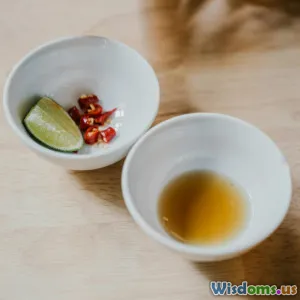
How to Layer Skincare Actives Without Damaging Your Barrier
7 min read Master the art of layering skincare actives without harming your skin barrier for a glowing, healthy complexion. (0 Reviews)
How to Layer Skincare Actives Without Damaging Your Barrier
In the bustling world of skincare, layering multiple actives has become a popular strategy to maximize benefits and tackle different skin concerns simultaneously. From antioxidants like vitamin C to exfoliants such as alpha hydroxy acids (AHAs), and powerful ingredients like retinol and niacinamide, the possibilities seem endless. However, many experience irritation, redness, or dryness — signs your precious skin barrier is compromised. So, the million-dollar question is: how do you layer skincare actives to enhance your skin health without damaging your barrier?
This comprehensive guide dives into the science of your skin barrier, the dos and don’ts of layering actives, and insider tips that dermatologists and skincare experts advocate. Get ready to transform your routine, protect your skin, and glow confidently.
Understanding Your Skin Barrier: The Foundation of Healthy Skin
Your skin barrier, scientifically called the stratum corneum, is the outermost layer of your skin — a complex matrix of lipids (fats) and corneocytes (dead skin cells) that functions like a shield. Its primary role is to lock moisturizer in and keep irritants, toxins, and harmful microorganisms out.
When this barrier is damaged, skin becomes sensitive, red, flaky, and vulnerable to infection or inflammation. Studies have shown that impaired barrier function correlates with skin conditions such as eczema, rosacea, and accelerated aging (Denda, 2020).
A balanced skincare routine respects and supports this barrier, making careful layering essential, especially if you use potent skincare actives.
The Power and Peril of Skincare Actives
What Are Skincare Actives?
Skincare actives are ingredients that cause a biological effect on the skin — think collagen production, exfoliation, or pigmentation reduction. Common actives include:
- Retinoids (e.g., retinol, tretinoin): Promote cell turnover and collagen.
- Vitamin C (ascorbic acid): Potent antioxidant and brightener.
- AHAs & BHAs (glycolic acid, salicylic acid): Chemical exfoliants that remove dead skin cells.
- Niacinamide: Anti-inflammatory and barrier-strengthening.
- Peptides: Signal skin to produce more collagen.
Why Layering Can Backfire
When combined incorrectly or applied in excess, these actives can disrupt the skin’s natural acidity (pH), cause inflammation, and even weaken the lipid matrix of the barrier. For example, layering retinol and benzoyl peroxide simultaneously has been shown to cause severe irritation (Kircik, 2013). Many experience redness or peel—clear indications your barrier is unhappy.
How to Layer Skincare Actives Safely and Effectively
1. Know the Compatibility
Before layering, research ingredient compatibility. For example:
- Retinol + Vitamin C: These can be layered but often require different pH levels — vitamin C prefers acidic pH, while retinol works best at neutral pH. Some recommend Vitamin C in the morning and retinol at night.
- Niacinamide + Vitamin C: Once thought incompatible, recent research suggests they can coexist comfortably at balanced pH.
- AHAs + Retinol: Can be too irritating layered together. Prefer alternating nights.
2. Patch Test and Introduce Slowly
Start using one active at a time, ideally once or twice a week, and gradually increase frequency. If irritation arises, step back and reduce usage. Patch testing on a small skin area avoids full-face reactions.
3. Apply from Thinnest to Thickest Texture
This helps the skin absorb actives more efficiently. Generally, a watery serum goes first (like a vitamin C serum), then treatments (like retinol), followed by emulsions and finally moisturizers.
4. Use Soothing and Barrier-Supporting Ingredients
Complement actives with ceramides, hyaluronic acid, and centella asiatica extracts to reinforce the barrier. These ingredients reduce inflammation and rebuild lipids.
5. Prioritize Sunscreen
Powerful actives like retinol and AHAs increase photosensitivity. Daily broad-spectrum sunscreen with at least SPF 30 is non-negotiable to protect your barrier and prevent damage.
6. Avoid Overuse
More is not better with actives. Tolerance varies widely. Studies indicate over-exfoliation, for instance, can lead to compromised barrier function within days (Rawlings et al., 2014).
Example Routine for Layering Actives Without Harm
Morning:
- Gentle cleanser
- Vitamin C serum (antioxidant protection and collagen boost)
- Niacinamide serum (barrier support, reduces inflammation)
- Moisturizer with ceramides
- Sunscreen SPF 30+
Evening:
- Gentle cleanser
- Chemical exfoliant (AHA/BHA) — start 1-2 times weekly
- Retinol serum (use on alternate nights from exfoliant)
- Hydrating moisturizer
This schedule staggers actives to avoid overstimulation while maintaining efficacy.
Expert Insights
Dr. Shereene Idriss, a board-certified dermatologist, emphasizes, “The key to healthy skin is honoring the skin barrier. Potent actives are amazing but overuse or improper layering quickly backfires, causing more harm than good.”
Similarly, a 2021 study in the Journal of Clinical and Aesthetic Dermatology underscores combining actives with hydration and barrier repair as critical to minimizing irritation and maximizing results.
Conclusion: Respect Your Skin’s Natural Defenses
Layering skincare actives is a nuanced art. With knowledge, patience, and care, you can harness the full power of these ingredients while preserving your vital skin barrier. Remember: your skin barrier is not just an obstacle—it’s your skin’s defense and foundation. Protect it wisely, and your complexion will radiate health and resilience.
Take the first step today—assess your current routine, introduce actives gradually, and embrace a barrier-friendly skincare ritual for glowing, balanced skin.
Rate the Post
User Reviews
Popular Posts




















